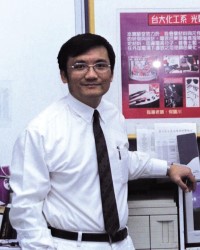本所成員
------------------------
師資陣容
職員
學生
校友
-------------------------
回首頁
-------------------------
國立台灣大學
------------------------- |
 |
|
何國川 教授
|
聯絡電話:
(02)2366-0739
電子郵件:
kcho@ntu.edu.tw |
■學歷
國立成功大學 化工學士,1978
國立成功大學 化工碩士,1980
美國羅徹斯特大學 化工博士,1986
PPG Industries, Inc. 研究計畫工程師, 1986-1993
|
■主要研究領域
電致色變材料與元件
電致色變現象是指材料伴隨電子轉移時導致之可逆顏色變化。經由人們的輸入訊號,電致色變元件能連續地改變透明度,可用於變色太陽眼鏡、天窗、遮陽板、後視鏡等商品上。因為輸入訊號的形式是直流電壓或電流,這些元件本質上可由使用者控制。目前我們正進行普魯士藍電致色變薄膜及其類似物的製備與鑑定,期對進出的離子在與電致色變材料的交互作用上有更進一步的瞭解。本研究涉及應用固態物理學、材料科學、高分子化學、電化學/電化學工程的原理,以改進電致色變材料與元件的長期穩定性。而其他與電致色變技術相關的材料,如導電高分子、透明電子與離子導體,也一併在研究之列。
電化學反應工程
電化學反應工程是將輸送現象、電化學平衡、電極動力學和材料科學的原理應用於化學程序中涉及電荷轉移反應的學門。最近幾年,電化學現象的重要性在許多工業製程裡逐受重視。經由進一步對電極材料的了解與設計,我們對發展嶄新的電化學反應器持有高度的興趣。例如原先在半導體工業使用的二氧化鈦鍍層透明電極,在本實驗室將其修飾改質充作光電化學反應器內之光觸媒與電極材料而用於水質的純化。其它的電極材料,例如聚苯胺和太菁也一併被研究;作為電化學式與半導體式氣體感測器內之感測電極而用於空氣污染之監測
|
■研究著作選列 Selected Journal Papers
- K. C. Ho, “At-Rest Instability of Tungsten Oxide-Prussian Blue Electrochromic System Incorporating Proton-Conducting Polymer Electrolytes,” PPG Technology Journal, 4, 55-68 (1998).
- K. C. Ho and J. C. Chen, “Spectroelectrochemical Studies of Indium-Hexacyanoferrate Electrodes Prepared by the Sacrificial Anode Method,” J. Electrochem. Soc., 145, 2334-2340 (1998). (SCI,EI)
- K. C. Ho, “The Influence of Charge Capacity Ratio on the Performance of a Complementary Electrochromic System,” Solar Energy Materials and Solar Cells, 56, 271-280 (1999). (SCI,EI)
- K. C. Ho, “Cycling and At-Rest Stabilities of a Complementary Electrochromic Device based on Tungsten Oxide and Prussian Blue Thin Films,” Electrochimica Acta., 44, 3227-3235 (1999). (SCI,EI)
- K. C. Ho, L. C. Chen, and C. C. Lee, “The Influence of Charge Capacity Ratio on the Optical Attenuation of a Tungsten Oxide-Polyaniline Electrochromic Device,” Proc. of SPIE, 3788, 120-131 (1999). (EI)
- K. C. Ho and C. L. Lin, “A Novel Potassium Ion Sensing based on Prussian Blue Thin Films,” Sensors and Actuators B: Chemical, 76, 512-518 (2001). (SCI,EI)
- L. C. Chen and K. C. Ho, “Design Equations for Complementary Electrochromic Devices: Application to the Tungsten Oxide-Prussian Blue System,” Electrochimica Acta, 46, 2151-2158 (2001). (SCI,EI)
- L. C. Chen and K. C. Ho, “Interpretation of Voltammograms in a Typical Two-Electrode Cell: Application to Complementary Electrochromic Systems,” Electrochimica Acta, 46, 2159-2166 (2001). (SCI,EI)
- K. C. Ho and Y. H. Tsou, “Chemiresistor-Type NO Gas Sensor based on Nickel Phthalocyanine Thin Films, “Sensors and Actuators B: Chemical, 77, 253-259 (2001). (SCI,EI)
- L. C. Chen and K. C. Ho, “Nonlinear Diffusion Behavior for the Prussian Blue Electrode: I. Variable Diffusivity Revealed by Potentiostatic Intermittent Titration Technique—Chronoabsorptometry,” J. Electrochem. Soc., 148, E282-E289 (2001). (SCI,EI)
- K. C. Ho and W. T. Hung, “An Amperometric NO2 Sensor based on Pt/Nafion Electrode, “ Sensors and Actuators B: Chemical, 79, 11-16 (2001). (SCI,EI)
- L. C. Chen and K. C. Ho, “Nonlinear Diffusion Behavior for the Prussian Blue Electrode: II. Interpretation of Variable Diffusivity during the Insertion/Extraction Processes, “ J. Electrochem. Soc., 149, E40-E44. (2002) (SCI,EI)
- C. L. Lin, C. C. Lee, and K. C. Ho, “Spectroelectrochemical Studies of Manganese Phthalocyanine Thin Films for Applications in Electrochromic Devices, “ J. Electroanal. Chem., 524-525, 81-89 (2002) (SCI,EI)
- C. L. Lin and K. C. Ho, “A Study on the Deposition Efficiency, Porosity, and Redox Behaviors of Prussian Blue Thin Films by an EQCM, “J. Electroanal. Chem., 524-525, 286-293 (2002). (SCI,EI)
- L. C. Chen, Y. H. Huang, K. S. Tseng, and K. C. Ho, “Novel Electrochromic Batteries: I. A PB-WO3 Cell with a Theoretical Voltage of 1.35V, “ J. New Materials for Electrochem. Systems, 5, 203-212 (2002). (SCI,EI)
- L. C. Chen, K. S. Tseng, Y. H. Huang, and K. C. Ho, “Novel Electrochromic Batteries: II. An InHCF-WO3 Cell with a High Visual Contrast, “ J. New Materials for Electrochem. Systems, 5, 213-221 (2002). (SCI,EI)
- L. C. Chen, K. S. Tseng, and K. C. Ho, “Enhanced Electrodeposition of Indium Hexacyanoferrate Thin Films through Improved Plating Solution Stability, “ J. Solid State Electrochem., 7, 1-5 (2002). (SCI,EI)
- L. C. Chen, Y. H. Huang, and K. C. Ho, “A Complementary Electrochromic System based on Prussian Blue and Indium Hexacyanoferrate, “ J. Solid State Electrochem., 7, 6-10 (2002). (SCI,EI)
- K. C. Ho, H. C. Ko, and L. C. Chen “Optical Attenuation for Complementary Electrochromic Devices: Application to the Tungsten Oxide-Polyaniline System, “ J. Ch. I. Ch. E., 33, 657-667 (2002). (SCI,EI)
- W. T. Hung and K. C. Ho, “An Electrochemical Sensor for Nitrogen Dioxide based on Pt/Nafion Electrode,” J. New Materials for Electrochem. Systems, 5, 305-313 (2002). (SCI,EI)
|
|